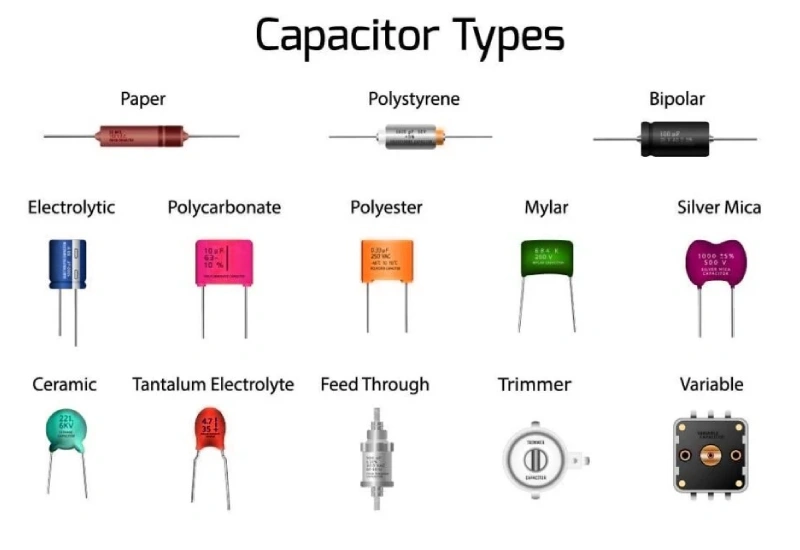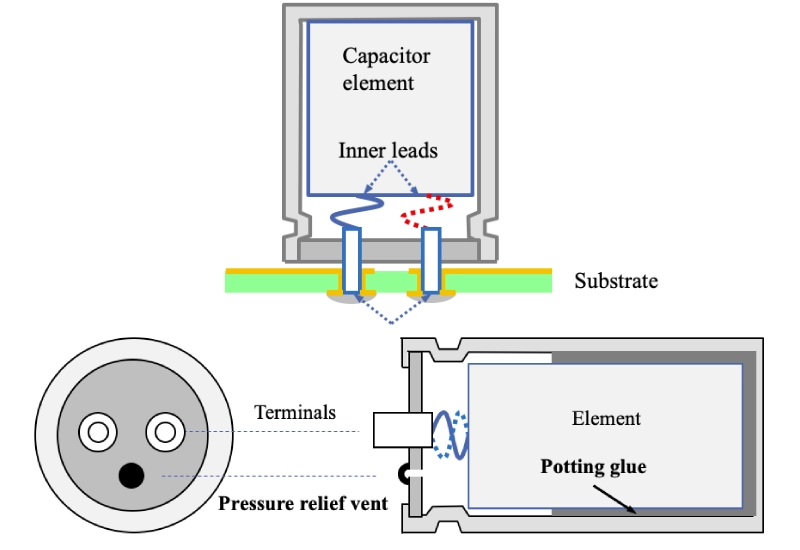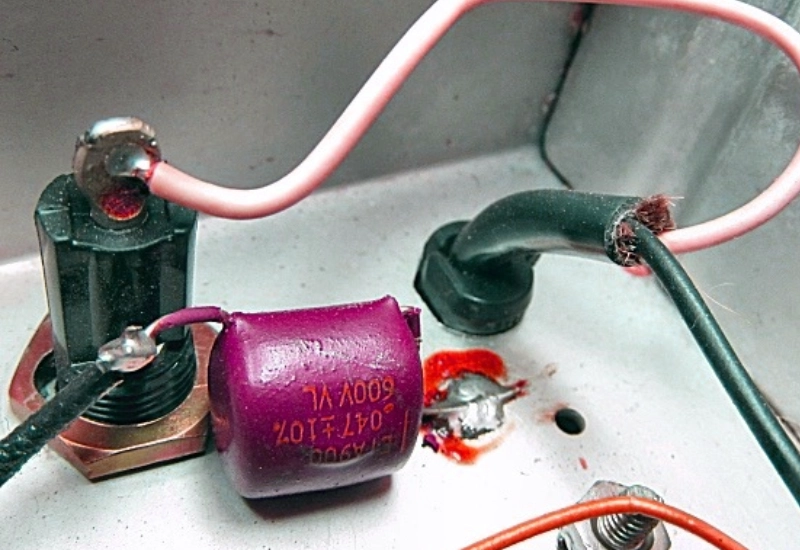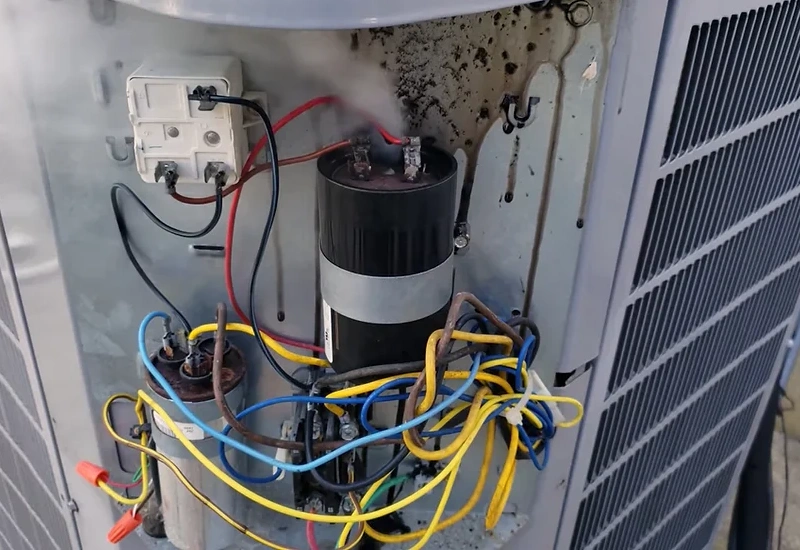
Capacitor death is when a capacitor loses its ability to store electrical charge. This can be due to factors such as age, overheating, or physical damage.
A capacitor is an electronic component that stores and releases electrical energy in a circuit. It consists of two conductive plates separated by an insulating material called a dielectric (like ceramic, paper, or plastic). When a voltage is applied across the plates, an electric field develops, causing an accumulation of opposite charges on each plate. This charge storage enables the capacitor to release energy when needed, often in bursts.
Capacitors have various uses, including filtering out noise in power supplies, stabilizing voltage and power flow, timing circuits, and energy storage in applications like camera flashes and motors. The capacity of a capacitor to store charge is measured in farads (F), with commonly used subunits like microfarads (μF) and picofarads (pF).
Capacitor death, also known as “capacitor failure,” occurs when a capacitor stops functioning correctly, often due to aging, electrical stress, or manufacturing defects. Capacitors store electrical energy, and when they degrade, they lose their ability to maintain charge, which can lead to device malfunctions.
What is a Death Capacitor

Common Causes of Capacitor Death:
- Aging: Over time, capacitors naturally degrade. Electrolytic capacitors, for example, have a limited lifespan due to the gradual evaporation or breakdown of the electrolyte material inside.
- Heat Exposure: Excessive heat accelerates degradation, causing materials inside the capacitor to expand or dry out, leading to leaks or ruptures.
- Electrical Stress: Voltage surges or prolonged exposure to high voltage can cause capacitors to overheat or exceed their voltage rating, resulting in failure.
- Manufacturing Defects: Poor-quality components or flawed manufacturing processes can lead to premature failure. “Capacitor plague,” for example, was an industry-wide issue in the early 2000s, where defective capacitors would fail within a few years.
Signs of Capacitor Death:
- Bulging or Leaking: A swollen or leaking capacitor is a common sign of imminent failure.
- Device Malfunction: When capacitors fail, devices may refuse to power on, reset frequently, or exhibit other erratic behavior.
- Burnt Smell or Visible Damage: Burn marks, discoloration, or an electrical smell can indicate that a capacitor has overheated.
Preventing Capacitor Death: Choosing high-quality capacitors, designing with proper cooling, and avoiding electrical overload can extend capacitor life. Regular maintenance and using capacitors within their voltage and temperature limits also help.
Common Causes of Capacitor Death

Capacitors are crucial components in many electronic circuits, but they can fail prematurely due to several factors. Understanding these common causes of capacitor death is essential for ensuring the longevity and reliability of electronic devices. Here are the main contributors to capacitor failure:
A. Overvoltage
Explanation of Voltage Ratings:
Every capacitor has a specified voltage rating, which indicates the maximum voltage the capacitor can handle without risk of failure. Exceeding this voltage can lead to breakdown of the dielectric material inside the capacitor.
Consequences of Exceeding Ratings:
When a capacitor experiences overvoltage, it can lead to dielectric breakdown, which may cause a short circuit within the capacitor. This often results in rapid heating, bulging, leaking, or even explosions in severe cases.
Example: In power supply circuits, transient voltage spikes (e.g., from lightning or switching) can momentarily exceed capacitor ratings, leading to failure.
B. Overheating
Sources of Excessive Heat:
Overheating can occur due to several factors, including high ambient temperatures, inadequate ventilation, or excessive ripple currents flowing through the capacitor.
Insufficient heat dissipation caused by poor circuit design can also lead to an elevation in temperatures.
Effects of Temperature on Capacitance:
High temperatures can cause the dielectric material inside the capacitor to degrade, leading to a loss of capacitance and increased equivalent series resistance (ESR). This degradation accelerates the aging process and can significantly shorten the capacitor’s life span.
C. High Ripple Current
Definition of Ripple Current:
Ripple current refers to the alternating current (AC) component that flows through a capacitor in addition to the direct current (DC) it is designed to filter. Ripple current can lead to heating within the capacitor.
How It Contributes to Failure:
When capacitors are subjected to high ripple currents, they may heat up due to the internal resistance (ESR) of the capacitor. This excess heat can lead to dielectric breakdown and potential failure. High ripple current is particularly common in power supply circuits and audio amplifiers.
D. Aging
Natural Degradation:
All capacitors undergo a natural aging process, where their materials deteriorate over time. Factors such as the quality of materials, environmental conditions, and operational stress influence the rate of aging.
Signs of Aging Capacitors:
Aging manifests as physical symptoms such as bulging canisters, leakage of dielectric fluid, or a decrease in capacitance. Even if not immediately visible, aging can reduce the reliability and performance of capacitors, particularly in high-stress applications.
E. Improper Installation or Handling
Potential Issues:
Capacitors can be damaged during installation if not handled properly. Issues such as soldering at excessively high temperatures or applying mechanical stress can lead to physical damage or premature failure.
Importance of Proper Care:
Following manufacturer guidelines for installation, including soldering techniques and ensuring proper orientation (in polarized capacitors), is critical to avoiding early failure.
F. Environmental Factors
Humidity and Contaminants:
High humidity environments can lead to corrosion on capacitor terminals, while contaminants can penetrate through seals, compromising the internal structure of the capacitor.
Physical Factors:
Exposure to extreme temperatures (both hot and cold), vibration, and mechanical stress can also impact a capacitor’s performance and longevity.
Symptoms and Indicators of Capacitor Failure

Capacitors are essential components in electronic devices. When they fail, it can lead to various issues. Here are some common signs of capacitor failure:
Visual Inspection:
- Bulging or Leaking: A physical sign of a capacitor failing is a bulging or leaking appearance.
- Discoloration: Changes in color, such as browning or blackening, can indicate internal damage.
Functional Symptoms:
- Device Failure: Capacitor failure can cause electronic devices to malfunction or completely stop working.
- Intermittent Issues: Devices may exhibit intermittent problems, such as unexpected restarts or freezing.
- Poor Performance: Reduced performance, such as slower loading times or distorted audio, can be a symptom.
Testing Methods:
- Capacitance Testing: Using a capacitance meter, measure the capacitor’s capacitance to determine if it’s within the specified range.
- ESR (Equivalent Series Resistance) Testing: ESR measures the internal resistance of a capacitor. High ESR indicates a failing capacitor.
By recognizing these symptoms and employing testing methods, you can identify and replace faulty capacitors to restore the functionality of your electronic devices.
Prevention of Death by Capacitor
Preventing Capacitor-Related Accidents
Capacitors, while essential components in electronic circuits, can pose serious risks if mishandled. To prevent accidents, consider these key points:
Component Selection and Circuit Design:
- Voltage and Temperature Ratings: Ensure capacitors are rated for the specific voltage and temperature conditions of the circuit.
- Quality Components: Choose high-quality components from reputable manufacturers.
- Overvoltage Protection: Implement measures like voltage regulators and surge protection devices.
- Thermal Management: Use heat sinks and adequate ventilation to prevent overheating.
Maintenance and Testing:
- Regular Inspections: Visually inspect capacitors for damage and measure their voltage and capacitance.
- High-Pot Testing: Apply high voltage to detect insulation failures.
- Leakage Current Testing: Measure leakage current to assess capacitor health.
By following these guidelines, you can significantly reduce the risk of capacitor-related accidents.
FAQ
Is It Dangerous to Handle a Failed Capacitor?
Yes, a failed capacitor can store a significant amount of electrical charge, even when disconnected from a circuit. It’s important to discharge the capacitor safely before handling it.
How Can I Prevent Capacitor Failure?
Proper circuit design: Ensure adequate voltage and current ratings for components.
Thermal management: Use heat sinks or fans to keep components cool.
Surge protection: Protect devices from voltage spikes.
What Happens if a Capacitor Fails in a Power Supply?
A failed capacitor in a power supply can cause the power supply to malfunction or fail, potentially damaging other components in the circuit.
Can a Failed Capacitor Cause a Fire?
In rare cases, a failed capacitor can overheat and cause a fire, especially if it’s in a confined space or near flammable materials.
Can a Capacitor Be Repaired?
Generally, capacitors cannot be repaired once they have failed. They must be replaced.
What is the Difference Between a Capacitor and a Battery?
While both capacitors and batteries store energy, capacitors store energy in an electric field, while batteries store energy in a chemical reaction. Capacitors can charge and discharge much faster than batteries.
Conclusion
In conclusion, capacitors are essential components in electronic circuits, storing electrical energy and performing various functions. Understanding the common causes of capacitor failure, recognizing the signs of a failing capacitor, and implementing preventive measures can significantly extend the lifespan of electronic devices and prevent costly repairs. By following the guidelines outlined in this article, you can ensure the reliable operation of your electronic equipment.